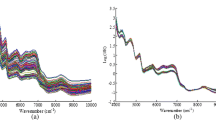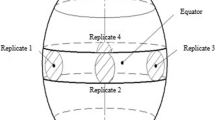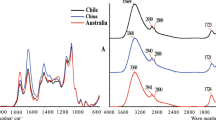Abstract
The feasibility of near-infrared (NIR) spectroscopy and chemometrics as tools to analyze Chinese Goji berry samples from four different topographical regions was investigated. Firstly, a consumer panel was asked to rate sensory attributes of the samples on a nine-point hedonic scale. Secondly, NIR original spectra of Goji berries in the wavelength range of 10,000–4000/cm were acquired. Least-squares support vector machine (LS-SVM) was firstly performed to calibrate the discrimination model to identify the geographical origins of the Goji berries, and the accuracy of correct identification was more than 96.67 %. Compared with artificial neural network (ANN) and K-nearest neighbors (KNN) approach, LS-SVM algorithm showed excellent generalization for identification results. Thirdly, as total flavonoid content (TFC) is highly related with the quality of the Goji berry, synergy interval partial least squares (Si-PLS) was applied to build the TFC prediction model. The determination coefficient for prediction (R p ) of the Si-PLS model was 0.9075, and root mean square error for prediction (RMSEP) was 0.376 mg/g. The three regions (4580–4860, 5720–6010, and 6290–6580/cm) selected by Si-PLS corresponded to the absorptions of two aromatic rings in the basic flavonoid structure. This work indicates that NIR spectroscopy combined with LS-SVM and Si-PLS offers significant potential and could be used as a rapid and efficient technique for evaluating the quality of retail Goji berries.





Similar content being viewed by others
References
Amagase H, Farnsworth NR (2011) A review of botanical characteristics, phytochemistry, clinical relevance in efficacy and safety of Lycium barbarum fruit (Goji). Food Res Int 44:1702–1717
Bondia-Pons I, Savolainen O, Törrönen R, Martinez JA, Poutanen K, Hanhineva K (2014) Metabolic profiling of Goji berry extracts for discrimination of geographical origin by non-targeted liquid chromatography coupled to quadrupole time-of-flight mass spectrometry. Food Res Int 63:132–138
Chen QS, Zhao JW, Liu MH, Cai JR, Liu JH (2008) Determination of total polyphenols content in green tea using FT-NIR spectroscopy and different PLS algorithms. J Pharmaceut Biomed 46:568–573
Chen QS, Zhao JW, Lin H (2009) Study on discrimination of Roast green tea (Camellia sinensis L.) according to geographical origin by FT-NIR spectroscopy and supervised pattern recognition. Spectrochim Acta A 72:845–850
Chen QS, Jiang P, Zhao JW (2010) Measurement of total flavone content in snow lotus (Saussurea involucrate) using near infrared spectroscopy combined with interval PLS and genetic algorithm. Spectrochim Acta A 76:50–55
Chen QS, Ding J, Cai JR, Zhao JW (2012) Rapid measurement of total acid content (TAC) in vinegar using near infrared spectroscopy based on efficient variables selection algorithm and nonlinear regression tools. Food Chem 135:590–595
Cheng JH, Dai Q, Sun DW, Zeng XA, Liu D, Pu HB (2013) Applications of non-destructive spectroscopic techniques for fish quality and safety evaluation and inspection. Trends Food Sci Technol 34:18–31
Chung IM, Ali M, Praveen N, Yu BR, Kim SH, Ahmad A (2014) New polyglucopyranosyl and polyarabinopyranosyl of fatty acid derivatives from the fruits of Lycium chinense and its antioxidant activity. Food Chem 151:435–443
De Bleye C, Chavez PF, Mantanus J, Marini R, Hubert P, Rozet E, Ziemons E (2012) Critical review of near-infrared spectroscopic methods validations in pharmaceutical applications. J Pharmaceut Biomed 69:125–132
Donno D, Beccaro GL, Mellano MG, Cerutti AK, Bounous G (2014) Goji berry fruit (Lycium spp.): antioxidant compound fingerprint and bioactivity evaluation. J Funct Foods. doi:10.1016/j.jff.2014.05.020
He HJ, Wu D, Sun DW (2015) Nondestructive spectroscopic and imaging techniques for quality evaluation and assessment of fish and fish products. Crit Rev Food Sci 55:864–886
Huang XL, Shi L, Suykens JAK (2014) Asymmetric least squares support vector machine classifiers. Comput Stat Data An 70:395–405
Jia ZS, Tang MC, Wu JM (1999) The determination of flavonoid contents in mulberry and their scavenging effects on superoxide radicals. Food Chem 64:555–559
Lai YH, Ni YN, Kokot S (2011) Discrimination of Rhizoma Corydalis from two sources by near-infrared spectroscopy supported by the wavelet transform and least-squares support vector machine methods. Vib Spectrosc 56:154–160
Li XM (2007) Protective effect of Lycium barbarum polysaccharides on streptozotocin-induced oxidative stress in rats. Int J Biol Macromol 40:461–465
Li BX, Wei YH, Duan HG, Xi LL, Wu X (2012) Discrimination of the geographical origin of Codonopsis pilosula using near infrared diffuse reflection spectroscopy coupled with random forests and k-nearest neighbor methods. Vib Spectrosc 62:17–22
Lin H, Zhao JW, Chen QS, Zhou F, Sun L (2011) Discrimination of Radix Pseudostellariae according to geographical origins using NIR spectroscopy and support vector data description. Spectrochim Acta A 79:1381–1385
Liu G, Zhang SH, Yang XL, Xu HB (2004) Immunomodulation and antitumor activity by a polysaccharide–protein complex from Lycium barbarum. Int Immunopharmacol 4:563–569
Liu HY, Qiu NX, Ding HH, Yao RQ (2008) Polyphenols contents and antioxidant capacity of 68 Chinese herbals suitable for medical or food uses. Food Res Int 41:363–370
Liu Y et al (2014) Virus-induced gene silencing in two novel functional plants, Lycium barbarum L. and Lycium ruthenicum Murr. Sci Hortic Amst 170:267–274
Prasad R, Pandey A, Singh KP, Singh VP, Mishra RK, Singh D (2012) Retrieval of spinach crop parameters by microwave remote sensing with back propagation artificial neural networks: a comparison of different transfer functions. Adv Space Res 50:363–370
Prieto N, Roehe R, Lavín P, Batten G, Andrés S (2009) Application of near infrared reflectance spectroscopy to predict meat and meat products quality: a review. Meat Sci 83:175–186
Qian JY, Liu D, Huang AG (2004) The efficiency of flavonoids in polar extracts of Lycium chinense Mill fruits as free radical scavenger. Food Chem 87:283–288
Qiao HT (2000) Rules of the inspection of fructus lycii for import and export vol 1. People’s Republic of China Exit Inspection and Quarantine
Reich G (2005) Near-infrared spectroscopy and imaging: basic principles and pharmaceutical applications. Adv Drug Deliv Rev 57:1109–1143
Roggo Y, Duponchel L, Huvenne JP (2003) Comparison of supervised pattern recognition methods with McNemar’s statistical test: application to qualitative analysis of sugar beet by near-infrared spectroscopy. Anal Chim Acta 477:187–200
Shi JY, Zou XB, Zhao JW, Mel H, Wang KL, Wang X, Chen H (2012) Determination of total flavonoids content in fresh Ginkgo biloba leaf with different colors using near infrared spectroscopy. Spectrochim Acta A 94:271–276
Shi JY, Zou XB, Huang XW, Zhao JW, Li YX, Hao LM, Zhang JC (2013) Rapid detecting total acid content and classifying different types of vinegar based on near infrared spectroscopy and least-squares support vector machine. Food Chem 138:192–199
Sinelli N, Spinardi A, di Egidio V, Mignani I, Casiraghi E (2008) Evaluation of quality and nutraceutical content of blueberries (Vaccinium corymbosum L.) by near and mid-infrared spectroscopy. Postharvest Biol Technol 50:31–36
Souza RFVD, de Giovani WF (2005) Synthesis, spectral and electrochemical properties of Al(III) and Zn(II) complexes with flavonoids. Spectrochim Acta A 61:1985–1990
Suykens JAK, Vandewalle J (1999) Least squares support vector machine classifiers. Neural Process Lett 9:293–300. doi:10.1023/A:1018628609742
Suykens JAK, Vandewalle J, de Moor B (2001) Optimal control by least squares support vector machines. Neural Netw 14:23–35
Suykens JAK, de Brabanter J, Lukas L, Vandewalle J (2002) Weighted least squares support vector machines: robustness and sparse approximation. Neurocomputing 48:85–105
Vapnik VN (1996) Book review: the nature of statistical learning theory. Technometrics 38:400–400
Wang CC, Chang SC, Inbaraj BS, Chen BH (2010) Isolation of carotenoids, flavonoids and polysaccharides from Lycium barbarum L. and evaluation of antioxidant activity. Food Chem 120:184–192
Wu SH, Wang YY, Gong G, Li F, Ren HT, Liu Y (2015) Adsorption and desorption properties of macroporous resins for flavonoids from the extract of Chinese wolfberry (Lycium barbarum L.). Food Bioprod Process 93:148–155
Xin TY, Gao HH, Zhou XZ, Ma XC, Xu CQ, Chen J, Han JP, Pang XH, Xu R, Song JY, Chen SL (2013) Super food Lycium barbarum (Solanaceae) traceability via an internal transcribed spacer 2 barcode. Food Res Int 54:1699–1704
Yang XW, Tan LJ, He LF (2014) A robust least squares support vector machine for regression and classification with noise. Neurocomputing 140:41–52
Yao X, Peng Y, Zhou Q, Xiao P, Sun S (2010) Distinction of eight Lycium species by Fourier-transform infrared spectroscopy and two-dimensional correlation IR spectroscopy. J Mol Struct 974:161–164
Zhang C, Su JH (2014) Application of near infrared spectroscopy to the analysis and fast quality assessment of traditional Chinese medicinal products. Acta Pharma Sin B 4:182–192
Zhang M, Chen HX, Huang J, Li Z, Zhu C, Zhang SH (2005) Effect of Lycium barbarum polysaccharide on human hepatoma QGY7703 cells: inhibition of proliferation and induction of apoptosis. Life Sci 76:2115–2124
Zheng H, Lu HF (2012) A least-squares support vector machine (LS-SVM) based on fractal analysis and CIELab parameters for the detection of browning degree on mango (Mangifera indica L.). Comput Electron Agric 83:47–51
Zheng GQ, Zheng ZY, Xu X, Hu ZH (2010) Variation in fruit sugar composition of Lycium barbarum L. and Lycium chinense Mill. of different regions and varieties. Biochem Syst Ecol 38:275–284
Zhu J, Liu W, Yu J, Zou S, Wang JJ, Yao WB, Gao XD (2013) Characterization and hypoglycemic effect of a polysaccharide extracted from the fruit of Lycium barbarum L. Carbohyd Polym 98:8–16
Acknowledgments
We thank the National Science and technology support program (2015BAD17B04), Chinese 863 Program (Grant Nos. 2011AA108007), Jiangsu Province Science Fund for Distinguished Young Scholars (BK20130010), New Century Excellent Talents in University (NCET-11-0986), Specially Appointed Professors by Universities in Jiangsu Province, the National Natural Science Foundation of China (Grant No.61301239), and the National Natural Science Foundation of Jiangsu Province (BK20130505). We also wish to thank Dr. M J Holmes who helped us refine the language.
Conflict of Interest
Shen Tingting declares that she has no conflict of interest. Zou Xiaobo declares that he has no conflict of interest. Shi Jiyong declares that he has no conflict of interest. Li Zhihua declares that he has no conflict of interest. Huang Xiaowei declares that he has no conflict of interest. Xu Yiwei declares that he has no conflict of interest. Chen Wu declares that he has no conflict of interest. This article does not contain any studies with human or animal subjects.
Author information
Authors and Affiliations
Corresponding author
Rights and permissions
About this article
Cite this article
Tingting, S., Xiaobo, Z., Jiyong, S. et al. Determination Geographical Origin and Flavonoids Content of Goji Berry Using Near-Infrared Spectroscopy and Chemometrics. Food Anal. Methods 9, 68–79 (2016). https://doi.org/10.1007/s12161-015-0175-x
Received:
Accepted:
Published:
Issue Date:
DOI: https://doi.org/10.1007/s12161-015-0175-x




